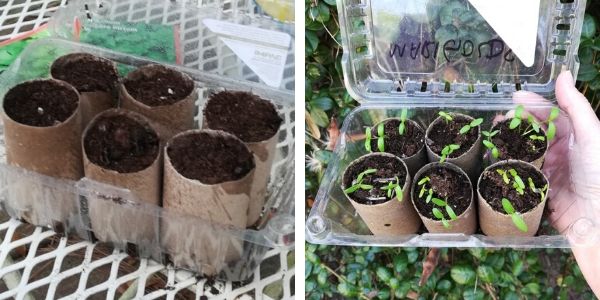5 Common Household Items You Can Repurpose For The Garden
Planting a garden requires time, money, and space. For it to be successful there are a few key things to do in preparation:
- Check out the Farmer’s Almanac to get the ideal planting date for your zone
- Determine the perfect location for your garden
- Decide on the plants you will grow
- Clear the area with a shovel or tiller
- Test the soil and amend as necessary
Once you’ve done your homework-there ain’t nothing to it but to do it.

This page contains affiliate links to products I use, love, and recommend. See my full disclosure policy.
Besides seeds and dirt here are a few of the things that you will find useful when it’s time to start your garden. Repurpose items you would normally throw away and save money on your garden supplies this year.
1) Toilet paper roll starter pots
Recycle empty toilet paper rolls, paper towel rolls, or gift wrap rolls. They make the best seed starter pots. Start by cutting them so that you have roughly 2″ rings. Put them in rows on a watertight tray. Fill the rings with a seed-starting medium and water thoroughly. Try filling the tray with water and let the seed starter pots absorb the water. It’s a little less messy than watering from the top.
Once the seed-starting mix is moist it’s time to add seeds. Take an old pencil and drill 3 holes about 1/4″ deep (the seed packet will have planting depth guidelines) into the little pot. Add 1 or 2 seeds per hole and lightly tamp the moist seed mixture over the holes. It’s a good idea to add more than one seed per hole because they may not all sprout.
Make sure to label or mark your rows with the seeds you have planted. Otherwise, you will have a mystery garden. Write on a wooden clothespin or popsicle stick with a sharpie to make the perfect plant marker.
Once the seeds have sprouted you are ready to put them in the ground or in the permanent container. Make sure all danger of frost has passed in your area.
The paper will protect the roots from insects and will ultimately break down in the soil.
Don’t throw away those empty rolls, reuse them as starter pots for your garden.
When you have enough for your garden explore other ways to reuse the empty roll.

2) Plastic milk or orange juice jugs
A gallon milk jug becomes a useful watering can just as it is.
Use a box cutter or razor knife and cut it in half, right below the handle and you have a plastic liner to use to turn a basket into a decorative planter.
The top section with the handle becomes a funnel that is perfect for filling the starter pots with soil OR for filling bird feeders with seeds.
Make a planter tray by cutting off the bottom of the jug at any depth you need.

3) Clamshell containers from the grocery store
These are the square or rectangular plastic containers with the attached lids that once held berries or cherry tomatoes. Wash them out and turn these containers into mini-nurseries or greenhouses for your seed starting pots. The deeper containers hold the 2″ starter pot and allow for some growth of the seedling. Leaving them in the “nursery” a bit longer will mean a stronger root system.

4) Single-use water bottles
Cut the bottom off the bottle and bury it upside down in a planter leaving an inch or so above the soil line. It becomes a very efficient waterer. When you water, simply fill the bottle and it will drain slowly and water the roots thoroughly.
5) Styrofoam meat trays
Wash with soap and water and dry well. Use these as trays for your starter pots. Adding water to the tray instead of on top of the seedlings protects the delicate plant. Water is absorbed from the bottom and the entire plant is watered.
The trays will last from year to year, they are easy to clean and easy to store at the end of the season.
Keep it manageable
It’s easy to bite off way more than you can chew when it comes to selecting seeds. Read the seed packet to find out germination time, flowering time, watering requirements. Have an idea of what harvest time looks like. Stagger planting time to make it more manageable.
Be prepared to harvest what’s ready and eat it, can it, freeze it, or give it away.
Lettuce is one vegetable with a short germination time and time to harvest. Staggered planting will guarantee that you have lettuce for weeks and weeks, instead of a LOT of lettuce at once.
If you are gardening with kids, look for seeds that are larger, like cucumber or marigolds, that are easier for little hands to manage. These in particular also have a very short germination time so they will see results very quickly.
Otherwise, the best vegetables to plant are the ones your family loves and will want to eat all summer.


